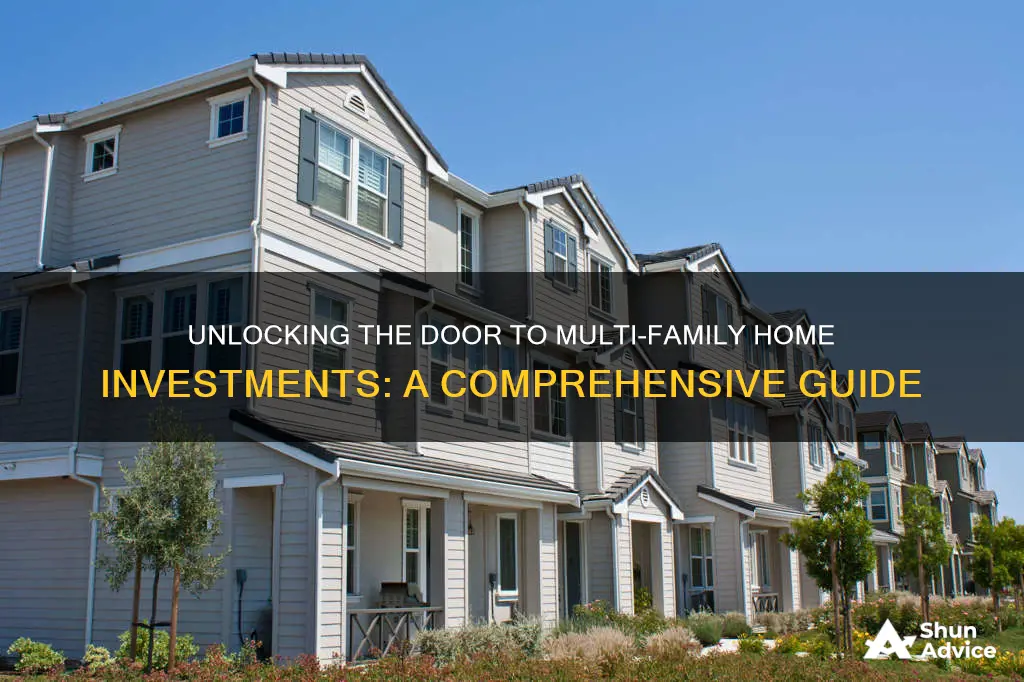
Investing in a multi-family home is a great way to get started with commercial real estate. It's a popular form of real estate investing because it's an asset class that most people can understand, having rented an apartment or owned a home previously.
Multi-family homes are designed for cash flow. They are generally built and sold for investment purposes, and they can be a great way to generate additional income without lifting a finger. It's easy to hire a property manager to take on the day-to-day responsibilities for you, which is particularly attractive to those with little experience owning or managing rental property.
There are several benefits to investing in multi-family homes, including:
- Cash flow
- Passive income
- Valuation potential
- Lowered risk
- Fewer loans
- Insurance simplicity
- Scalability
- Tax benefits
- Diversity of product types
- Multiple investment mechanisms
| Characteristics | Values |
|---|---|
| Purpose | Boost income, Expand investment portfolio, Reduce living costs, Generate passive income |
| Property type | Apartment complexes, Condominiums, Duplexes, Triplexes, Four-plexes, Mixed-use properties |
| Financing | Easier to finance than single-family homes, Higher down payment, Commercial property loan for 5+ units |
| Income | Multiple streams of income, Potential for higher income, Predictable and routine NOI |
| Risk | Reduced investment risk, Lower risk of vacancy, Lower risk compared to other real estate asset classes |
| Management | More time and effort required, Potential to hire property management company |
| Tax | Tax advantages, Ability to depreciate property value and offset rental income |
| Location | Appealing to renters, High-growth and high-yield areas, Well-maintained neighbourhoods |
| Number of units | 2-4 units for first-time investors, Ability to scale with more units |
| Owner-occupied | Potential to live in one unit and rent out others, Advantageous financing and management |
What You'll Learn

How to finance a multi-family home
Financing a multi-family home is similar to getting a loan for a single-family home. Here are the steps you can take to finance a multi-family home:
Step 1: Understand your loan options and eligibility
First, you need to understand what options are available to you based on your goals and qualifications. The specific terms and eligibility criteria will vary based on the type of multifamily financing you choose. Your business goals and qualification requirements will determine the type of financing best suited for you. The four main types of multifamily loans in the US include:
- Conventional multifamily mortgages
- Government-backed multifamily mortgages
- Short-term multifamily loans
- Portfolio/private multifamily loans
Step 2: Find a lender
Your options for lenders include banks, credit unions, online lenders, and loan brokers. Each has its own set of pros and cons. Banks, for example, often have a wide range of loan types, but qualification criteria tend to be strict with little flexibility. Credit unions can offer more competitive rates than banks, but may not have as many products. Online lenders can offer competitive pricing but require you to be comfortable conducting business online. Loan brokers can match you with the loan that best suits your needs but may charge a fee for their services.
Step 3: Submit a loan application
Once you've found a lender and determined that you meet the eligibility criteria, you can submit a formal loan application. As part of the application process, you'll be asked to provide supporting documentation, such as tax returns, bank statements, and other financial statements. The lender will review these documents to confirm your eligibility and determine the loan terms.
Step 4: Choose a multifamily home
When choosing a multifamily home, consider the location and the number of units. Multi-family homes with five or more units are considered commercial properties and will require a commercial lender. You'll also need to think about the cost and your ability to make the necessary down payment.
Step 5: Work with a real estate agent
Consider working with a real estate agent who can help you find a suitable property, negotiate on your behalf, and provide insight into the local market.
Step 6: Make an offer
Once you've found a property you want to buy, work with your real estate agent to determine a reasonable price and decide on any contingencies you want to include in your offer.
Step 7: Close the deal
If your offer is accepted, you'll need to purchase homeowners insurance, arrange for an inspection, and handle any other closing costs.
Tips for financing a multi-family home:
- Compare interest rates and loan terms from different lenders to get the best deal.
- Consider working with an approved lender for government-backed loans such as FHA or VA loans.
- Keep your credit score and debt-to-income ratio as favourable as possible to increase your chances of loan approval and to get a lower interest rate.
- Be prepared to make a higher down payment for a multi-family home than you would for a single-family home.
- If you plan to live in one of the units, you may be able to get a lower interest rate and a smaller down payment.
Diversifying Savings: Beyond Stocks and Bonds
You may want to see also

The benefits of investing in multi-family homes
Multi-family homes are an attractive investment option for many. Here are some of the benefits of investing in multi-family real estate:
Steady Cash Flow
One of the main advantages of investing in multi-family homes is the steady cash flow they provide. With multiple tenants, investors can expect consistent rental income each month, even if there are vacancies or budgetary issues. This consistent cash flow is not always guaranteed with other types of investments, which may be subject to significant fluctuations.
Passive Income
Multi-family real estate is an excellent way to generate passive income. Investors can hire a property management company to handle the day-to-day responsibilities, making it a hands-off investment. This is especially attractive to those with little experience in owning or managing rental properties.
Portfolio Diversification
Multi-family homes offer an easy and fast way to diversify your investment portfolio. By investing in a multi-family property, you can quickly go from owning nothing to owning multiple homes. This provides multiple income streams and the convenience of managing properties in one location.
Affordability
Multi-family homes can be more affordable to acquire and maintain than other types of real estate properties. The cost per unit is often lower, making it a more cost-efficient investment. Additionally, mortgage financing rates tend to be lower for multi-family homes, and foreclosure rates are typically reduced compared to single-family units.
Low Risk
Multi-family properties are considered a relatively low-risk investment compared to other real estate options. Even during an economic downturn, people still need a place to live, and there may be increased demand for rental housing. With multiple tenants, the risk of complete vacancy is lower, providing a more stable income stream.
Tax Benefits
Multi-family real estate investments offer unique tax advantages. Investors can claim real estate investor status and benefit from mortgage interest deductions, depreciation allowances, and tax-free exchanges under specific provisions. These tax benefits can help offset a significant portion of the rental income collected each year.
Invest Now: Hot Trends
You may want to see also

How to find multi-family homes for sale
There are several ways to find multi-family homes for sale. Here are some strategies to help you get started:
Check Local Listings
Before looking further afield, it's worth checking what's available in your local area. Keep an eye out for "For Sale" signs, and check local newspapers, magazines, and word-of-mouth information. You may find that your ideal property is just down the road!
Online Platforms and Tools
Take advantage of the many online platforms and tools dedicated to property listings and searches. These include:
- LoopNet
- Homes.com
- Realtor.com
- Mashvisor
- MLS (Multiple Listing Service)
These platforms allow you to search for properties in your desired location and compare pricing. Some platforms, like Mashvisor, offer additional features such as investment property analysis and heatmap analysis.
Hire a Real Estate Agent
Consider hiring a real estate agent to aid in your search. Agents have access to investment tools and expansive networks to find properties that match your criteria. Make sure to find an agent who is qualified and experienced in finding multi-family real estate listings.
Auctions
Another way to find multi-family homes is through auctions, including foreclosure auctions. Auction properties are often sold below market value, making them an attractive option for buyers. Keep in mind that auction transactions usually involve cash payments.
Open Houses
Participating in open houses allows you to directly connect with sellers and quickly view the property. This can expedite the buying process and help you gather information about the property.
Mortgage or Investment: Where Should Your Money Go?
You may want to see also

How to analyse a multi-family home investment
Analysing a multi-family home investment is a critical step in the process of purchasing such a property. Here is a detailed, step-by-step guide on how to do it:
Step 1: Determine the Net Operating Income (NOI)
This is a crucial metric that indicates how much income you can expect after covering the day-to-day financial demands of the property. You can calculate the NOI using the following formula:
> NOI = Total Income – Total Operating Expenses
The total income includes various fees such as pet fees, late fees, and coin-operated laundry. The total operating expenses include vacancy rates (5%-10% of rent), taxes, insurance, maintenance, management, and utilities. By subtracting these expenses from the total income, you will determine the NOI.
Step 2: Calculate Cap Rates
Cap rates, or capitalisation rates, represent the expected rate of return on your investment in real estate. They are calculated as follows:
> NOI / Value = Cap Rate
For example, if a property has an NOI of $50,000 and is listed for $500,000, the cap rate would be 10. Understanding cap rates is essential when deciding which property to invest in.
Step 3: Find the Right Location
The location of your multi-family property will significantly impact its value, especially in the long term. Research the neighbourhood, the city, and the surrounding areas to understand the potential for growth and desirability. Look into crime rates, demographic makeup, and economic stability to gauge whether the location is likely to attract tenants in the future.
Step 4: Perform a Comparable Search
Research the rental rates of similar multi-family units in the area to get an idea of the potential rental income for your property. Also, consider the selling prices of comparable multi-family properties nearby. Take into account the age and condition of these properties when making your comparisons. This will help you determine if the numbers for your potential investment make sense.
Step 5: Visit the Property
Don't underestimate the value of physically visiting the property and its surroundings. Drive through the neighbourhood, walk the grounds, inspect common areas and units (if possible), and ask yourself what improvements need to be made. This will give you a more comprehensive understanding of the property and help you make a more informed investment decision.
Step 6: Crunch the Numbers
Finally, there are several other calculations you can perform to thoroughly analyse the investment potential of a multi-family home:
- Cash flow: This is the profit you will make after considering all expenses, including the mortgage payment. You can calculate it as follows: Cash flow = NOI – (Mortgage payment + reserves for CapEx).
- ROI: To determine the return on investment, use the following formula: ROI = Cash flow / Investment Cost (down payment + closing costs + rehab costs).
- Net ROI: To calculate the net ROI, consider factors such as tax benefits, equity build-up, and increased property valuation. The formula is: Net ROI = Total Return / Investment Cost.
Retirement Savings: Navigating the Investment Maze
You may want to see also

How to manage a multi-family home
Managing a multi-family home can be a challenging but rewarding endeavour. Here are some tips to help you effectively manage a multi-family property:
- Conduct Thorough Research: Before purchasing a multi-family property, it is crucial to perform extensive research. Understand the rental market trends, the future development potential of the property, the longevity of rental agreements, and any required improvements or current issues. Ask yourself questions about financing, competitive advantages, and how your offering fits the neighbourhood. Making an informed decision will set the foundation for successful management.
- Hire a Real Estate Lawyer: Don't skimp on legal advice when investing in a multi-family property. A real estate lawyer can review contracts, search for liens or judgments, and facilitate the closing process. Their expertise will help protect your interests and ensure a smoother transaction.
- Familiarise Yourself with Property Management Software: Utilise technology to streamline the management of your multi-family property. Multi-family property management software can help you stay on top of tasks such as advertising vacancies, tenant acquisition, rent collection, and property maintenance. This software is typically accessible online, making it easy to manage your property remotely.
- Choose the Right Tenants: Tenant selection is critical to the success of your investment. Screen potential renters by asking questions about their income, eviction history, and their reasons for moving. Conduct background and credit checks to further minimise risk. A good tenant will help keep your property safe and contribute to a positive living environment.
- Maintain Your Property Regularly: As a landlord, it is your responsibility to ensure your tenants live in habitable conditions. Stay compliant with habitability laws by addressing issues like mould, pests, structural repairs, and appliance malfunctions. Conduct regular inspections, including move-in, move-out, seasonal, and drive-by inspections, to proactively identify and address any problems.
- Build a Good Relationship with Your Tenants: Nurturing a positive landlord-tenant relationship is essential for retaining tenants and fostering a pleasant living environment. A good relationship can also lead to more references and a stronger reputation for your property. Remember, your investment's success is tied to happy tenants.
By following these tips and staying dedicated to the management of your multi-family property, you can optimise your investment's potential and create a positive experience for both yourself and your tenants.
Retirement Planning: The American Investment Journey
You may want to see also
Frequently asked questions
A multifamily property is any residential property that contains more than one housing unit. Duplexes, townhomes, apartment complexes, and condominiums are common examples of multifamily properties.
There are several benefits to investing in a multifamily property, including the potential for higher cash flow, passive income, and valuation. Multifamily properties are also considered a relatively ""safe" investment compared to other real estate asset classes as they tend to be in demand even during economic downturns.
Some things to consider include the cost and location of the property, the total number of units, the potential income, and the management intensity. It is also important to evaluate your financing options and conduct thorough due diligence before making a purchase decision.







